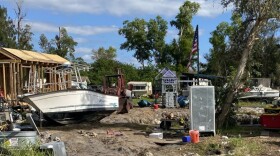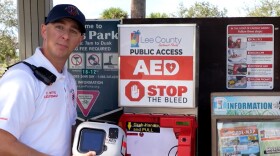As the sun rises over St. Pete Beach, Tracy Andrews walks across the sand searching for turtle crawls.
Turtle crawls are turtle tracks left by pregnant loggerhead sea turtles, who climb ashore to lay nests. Off the shore, Bruno Falkenstein sits behind the steering wheel of an old bass boat. He holds binoculars, scanning the area for tracks to investigate with Andrews.
Falkenstein is the president and founder of the Sea Turtle Trackers, a nonprofit group dedicated to tracking and protecting turtle nests across St. Pete beaches. His organization reports that sea turtle nests have been increasing year to year.
Sea turtles are a threatened species in the United States and considered endangered internationally. The greatest threat to the loggerhead sea turtle is the destruction of its nesting habitat, according to the Sea Turtle Conservancy.
On the morning of Tuesday, July 14, Falkenstein wanted to search both Shell Key and Outback Key, underdeveloped islands south of Pass-A-Grille Beach, for new crawls and check on the older nests.
Falkenstein and Andrews spotted coyote tracks near the nests. There is also a chance some of the old nests have been damaged by tropical storm Colin, which brought heavy rainfall and flooding in June of this year.
Falkenstein can’t do much about either, except set out precautions, like chicken wire and smaller protective cages to prevent predators from eating the eggs.
“In a lot of ways we have to let nature take its course. Keeping up the habitat is just as much part of the job as protecting the nests,” he said.
Andrews, a volunteer, has been working with the Trackers for over a year. While on the shore, she covers old tracks so other volunteers don’t mistake them for new. While raking the sand, Andrews explained how she came to find the nonprofit group.
“It took me a few weeks to find the organization. I was walking the beaches of Pass-A-Grille and saw the nests. They had a website, so I got on the website and asked to be a volunteer,” she said.
Andrews and Falkenstein go out together most mornings unless the weather causes more than two-foot waves. In that case, Falkenstein goes out by himself. He said that the boat the Trackers use can’t handle the harsher weather. They also use a 1966 CJ6 Jeep to drive on to the beach. Falkenstein said that it was prone to breaking down.
The nonprofit organization survives on donations and their “adopt a nest” program. For $50, a nest will be marked with a handcrafted turtle sign that signifies the adopter of the nest. After the eggs hatch, the Trackers send photographs and statistics to the patron. Falkenstein said that baby turtles are a rare sight, but if the adopted nest has any stragglers, there will be pictures of them sent over as well before the Trackers release it into the water.
At the start of the operation, more than 37 years ago, Falkenstein primarily supported the Trackers. He is the co-owner of the Hurricane Restaurant and is a former city commissioner for District 4 on St. Pete Beach. He advocates and educates school children about sea turtles and their nests.
On this day, Falkenstein and Andrews are disappointed. They couldn’t find any new turtle nest on their outing. But on the way back to their dock, Andrews gets a call from another volunteer who has found tracks, but can’t locate the eggs.
When Andrews arrives at the site, located near the Don Cesar Resort, she finds a mystery.
This turtle crawl is unusual. After reaching a spot on the shore, the turtle turns around to return to the sea. While returning, the turtle became confused.
The female loggerhead zigzagged more than 600 meters down the beach, knocking over a large blue trash can before finally reaching the water.
“It’s not unusual to see them crawl long ways,” Andrews said. “They may do a bit of a loop-de-loop but they generally make it to the water. To see her do this is sad. That she had to go that far and wear herself out that much. But she made it to the water and that’s the important thing.”
Lights from a nearby condo are a likely suspect. Sea turtles use moonlight to guide them back to water. Artificial lights tend to lead them in the wrong direction. In the past, whole nests have been lost due to the baby turtles following the wrong light source away from the ocean.
The spot where the female turtle turned around looks like a nest. The dirt looks recently upturned.
After five minutes of looking for the eggs, a team of volunteers is joined by Joe Widlansky, nicknamed “Turtle Joe.” He is the vice president of operations for the Trackers. He and Andrews, along with a few other volunteers, have to visibly locate the eggs before recording it as a nest. The information they gather will go to the Florida Wildlife Conservation Beach Survey, which monitors turtle nests across Florida’s beaches.
One volunteer said that Widlansky has divining fingers. After a few seconds of digging, he is able to find the eggs.
After the nest is geotagged and recorded, volunteers will return after 60 days to monitor the nest at night. When the eggs hatch, volunteers ensure that the baby turtles make it to the water.
If the turtles make it to the water safely, they will return as adults ready to lay their eggs on the same beaches.
That is the goal: to keep the turtle populations rising and their habitat safe.
Copyright 2020 WUSF Public Media - WUSF 89.7. To see more, visit WUSF Public Media - WUSF 89.7. ![]()







